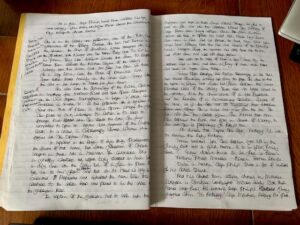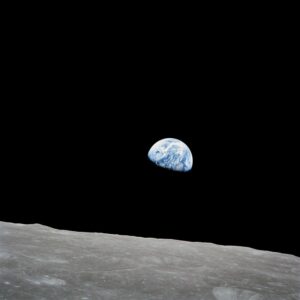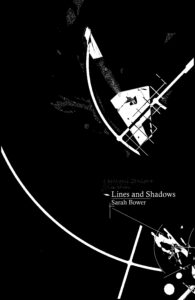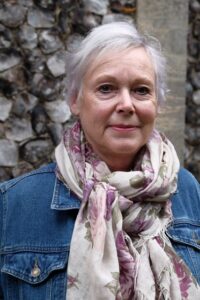Creative Writing PhD student and Associate Lecturer Sarah Bower found herself inadvertently crafting a novella during the second lockdown summer of 2021. Ahead of Monday’s online event with fellow OU novella writer Emily Bullock, Sarah unveils how writing a novella helped her uncover hidden layers of her larger literary endeavors.
Rather as Withnail and I went on holiday ‘by mistake’, in the second lockdown summer of 2021 I wrote a novella by accident. In August 2023, it was published by Story Machine as Lines and Shadows. Admittedly, it seems an odd sort of mishap, and you would be within your rights to doubt my assertion that it was an accident at all because who writes an entire book – even a short one – by accident?
Let me tell you how and why it happened.
I was in the first summer of my PhD in creative and critical writing, for which I am writing a much longer novel, part of which, set in 1968 and 69, is about the role of women in the manufacture of spacesuits for Apollo. End of year marking was over, there was little or no prospect of diversions such as test cricket or holidays. The PhD beckoned. I opened up the file…
 …and picked up a notebook in which I started writing, by hand and with no conscious forethought, something completely different.
…and picked up a notebook in which I started writing, by hand and with no conscious forethought, something completely different.
I headed it ‘Ghost Story’ and wrote: ‘The letter from the Ministry of Defence was lying on Ginny Matlock’s plate when she came down to breakfast.’ Beyond that point I knew very little.
Fiction writing is a peculiar process. The writer is split between the mechanical brain which wields the pen or types on the keyboard, undertakes the research, knows how to spell and where to put a comma (most of the time). Then there is the parallel universe of the imagination in which she is not only not herself but may be many others. F. Scott Fitzgerald wrote, in The Last Tycoon, ‘Writers aren’t people exactly. Or, if they’re any good, they’re a whole lot of people trying so hard to be one person.’ The writer is never entirely in control of all these people and sometimes, the ones who have been waiting patiently in the background – perhaps for years – decide they’re tired of waiting and elbow their way to the front of the queue.
The character waiting for me was, in the Romantic tradition, a place: the Suffolk coastal town of Orford. I had lived in Suffolk and known I wanted to write about Orford for many years, not only for its bleak, beautiful and ever shifting landscape. I had written about the East Anglian coastline and its unpredictability before, in my novel Erosion. But Orford has a strange history, which transports the imagination from a medieval merman to nuclear weapons testing and Cold War listening posts. It had lain dormant in my subconscious for twenty years or more, and it was initially a mystery to me why it chose to rise to the surface in that particular summer.
The novella is set between 1960 and 1962, culminating with the Cuban Missile Crisis, in a fictional village called Aldeford. This is closely based on Orford but the inability to conduct either location research or visit the relevant archives in Ipswich due to lockdown meant that I could not achieve the historical accuracy necessary to set my story in the real place. This was liberating, however, as was scribbling in a notebook in the unstructured spaces of my day – while waiting for the kettle to boil, eating breakfast, watching the bath run. I was daydreaming on paper. The characters conjured into being this way – Ginny, the mathematics prodigy from Manchester, her society girl housemates, the Korean war hero Philip and the mysterious Artist – had the freedom to do as they wished and to tell me what they wanted to.
It wasn’t until they had finished and fallen silent that I understood their function in the process of a whole lot of people trying to become me. I realised, during the course of discussions with my editor which helped to sharpen the novella’s focus, that its creative impulse was a means of delving into the deep backstory of my PhD. It prepared the ground for writing about the proxy war that was the space race and the real war in Vietnam that was the grisly underbelly of America’s triumphant moonshot. Kennedy became president in 1960 and made his ‘We Choose to Go to the Moon’ speech at Rice University in 1962, a month before the missile crisis. While my characters’ lives and loves and encounters with ghosts and spies were unfolding on a secret airforce base in Suffolk, the building blocks for 1968 – for everything from student riots to Earthrise – were being assembled in America.
Lines and Shadows is my first novella. At 40,000 words it is long for the form but about half the length of a novel.
Perhaps, in the context in which I was writing, it took this form because the novella too shape shifts like the Orford coast. Neither novel nor short story, it is commonly seen as originating in fourteenth century Italy with Boccaccio’s Decameron. The word ‘novella’ translates from Italian as ‘a short story related to true, or apparently true, facts.’ What better way to describe a book written by accident, set in a fictional version of a real place and tucked into the corners of another book altogether.
Sarah Bower is an Associate Lecturer at the OU, where she is also reading for a PhD in creative and critical writing. She is the author of three previous novels. Her first, The Needle in the Blood, winner of the 2007 Susan Hill Award, was re-issued in September 2023. She also writes short fiction and has edited anthologies of memoir and of literary translations into English. She is currently working on a book of prompts and inspirations for creative writing for imprisoned people.




